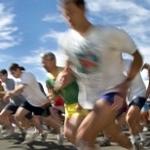
Why the fit drop dead (occasionally)
29 February 2016, 9:13AM
Neil Averis
Death while exercising is not uncommon and is usually from a heart attack yet we promote exercise as a means to prevent heart problems.
It is true that people whom exercise on a regular basis are much less likely to have a heart attack, some studies would suggest an almost 50% reduction of risk in this group. Despite this reduction heart attacks are very common and are by far the leading cause of death especially in males 40 to 60, even if they are fit and active.
We also know that exercise can act as a trigger for an incipient heart attack so that although fit individuals are less likely to have a heart attack or myocardial infarction, if they do have one, it is likely to be while they are exercising.
The reasons for this seeming contradiction, is that we all build up deposits of atheroma or plaque in our arteries as we age. If that was just a steady gradual accumulation process then that would lead to gradually increasing restriction of blood flow to the heart muscle.
This would mean that muscle would have a restricted work capacity so the athlete would notice a restriction in performance. Indeed a sign of moderately to severely blocked coronary arteries may just be an inability to run uphill as well as you should, or a reduction in TT times or sustainable wattage.
If the cardiac muscle is more severely lacking in oxygen from even more restricted blood flow it will also start to hurt, and this pain is called angina.
Angina is a pressure feeling or pain usually in the chest but may be in the upper back or neck or even radiate into the arms.
Lots of other things can cause chest pain (indigestion, muscle or rib sprains) but angina pain is characterised by its relationship to exercise.
Angina will come on once a certain effort level is reached and on resting will usually fade once the muscle rests and can “catch up” on their oxygen deficit. Drugs like nitroglycerine mouth spray may relieve or prevent angina by acting to temporarily open up the blood vessels and are useful as treatment and to help with the diagnosis.
This gradual blocking process explains lack of performance, angina pain and would explain gradual development of heart failure but does not explain a sudden event like a heart attack.
Here something different happens, which can cause a sudden major blockage in a coronary artery. In most cases the cause is plaque rupture. Atheroma or plaque is made up of fatty cholesterol rich calcified deposits that then can tear off and block that artery or a more distal narrower branch. This sudden cessation of blood flow will totally deprive the downstream cardiac muscle of oxygen which will cause sudden chest pain and cardiac muscle irritability leading to ventricular fibrillation. Ventricular fibrillation is where the cardiac muscle loses its controlled contraction that allows blood to be pumped efficiently and just fibrillates, or twitches like a bag of worms, pumping no blood. Death will soon occur within minutes from brain damage as well as cardiac muscle damage unless circulation is restored.
Classically the sufferer clutches his or her chest and will collapse if in ventricular fibrillation or may remain conscious but pale and sweaty, usually with severe chest pain if ventricular fibrillation has not yet occurred.
In the collapsed unconscious patient it is vital to start CPR (cardio pulmonary resuscitation) as soon as possible once you have checked for dangers. Someone should call an ambulance 111 and if there is an AED (automatic emergency defibrillator) nearby it should be brought to you and the start button pushed and audio prompts followed.
Don’t hesitate to act, you can do no harm and may save a life. If the AED can be used in those first minutes a shock has a decent chance of changing ventricular fibrillation back into a rhythm that pumps blood.
Waiting for ambulances or expert help will likely result in death, prompt CPR and a shock from an AED may save a life. AEDs are designed for use by untrained people and have audio that tells you what to do. They can be found in public buildings, malls, gyms, movies, airports, sports grounds and doctors surgeries. They will not shock unless they detect ventricular fibrillation, so are safe in someone who has collapsed from other causes such as severe faints, alcohol or drug effects, diabetes or epilepsy.
Find out if there is one near where you work and google its brand to be familiar with its use, there is likely to be a simple instructional video on line. Update your CPR skills, they have become simpler with emphasis on good chest compressions and getting the AED used as soon as possible.
Breathing (usually mouth to mouth) is much less important than chest compressions and getting that life saving shock delivered as soon as possible. This is because good chest compressions can ventilate the lungs enough as well as circulate blood.
So although fit athletic people are less likely to have a heart attack, if they do have one it is most likely to occur while exerting themselves because that is when blood flow is greatest so plaque rupture most likely.
If someone suddenly collapses during an event, a heart attack is very likely; if someone collapses after an event, a heart attack is still possible but other causes like faint from dehydration are more possible. In these cases they may be briefly unconscious but will still be breathing and have a pulse. The person in ventricular fibrillation however has no pulse, nor any breathing and is already dead unless action is taken.
